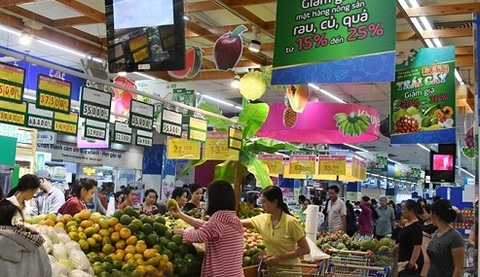
A supermarket in Ha Noi. During the first half of this year, the retail sector earned about VND1.89 quadrillion. — Photo thuongtruong.vn
Viet Nam’s total retail sales and service revenue hit VND431 trillion (US$18.6 billion) in June, up 6.2 per cent month-on-month and 5.3 per cent year-on-year.
However, the figure in the first six months of this year decreased by 0.8 per cent to about VND2.38 quadrillion ($103 billion) compared to the same period last year, according to the General Statistics Office (GSO).
Total revenue in the second quarter was VND1.15 quadrillion, down 5.8 per cent from the previous quarter and 4.6 per cent from a year ago.
During the first half of the year, the retail sector earned about VND1.89 quadrillion, an annual increase of 3.4 per cent, the office said. The rise was attributable to the abundant supply of goods and thriving online shopping, particularly during the COVID-19 social distancing period, reported chinhphu.vn.
Online shopping has become increasingly popular, especially when social distancing measures were put in place.
A number of localities enjoyed increases in retail sales of goods, including Hai Phong by 10.4 per cent, HCM City 10.1 per cent, Ha Noi 9.9 per cent, Dong Nai 8.4 per cent, Binh Dinh 4.3 per cent, Ba Ria-Vung Tau 3 per cent, and Thanh Hoa 0.9 per cent.
The accommodation and catering services in the first six months earned just VND234.7 trillion, down 18.1 per cent against the same period last year.
The tourism revenue also followed suit with an annual reduction of 53.2 per cent. In the first half, the sector reeled in just VND10.3 trillion due to a hiatus in welcoming foreign visitors to control the spread of COVID-19. Meanwhile, the summer school holidays are yet to arrive, resulting in a less vibrant domestic travel market.
With the EU-Viet Nam Free Trade Agreement (EVFTA) effective from August, retail experts have said the domestic industry would have plenty of opportunities and challenges in the near future.
Vu Vinh Phu, a retail industry expert, said local firms will be put under great pressure as an array of different kinds of goods will be exported to other countries, while goods from different nations will enter the Vietnamese market much more freely.
Moreover, goods from abroad hold advantages in terms of quality. They also follow diversified innovative models and are reasonably priced, meaning Vietnamese goods look set to encounter increasingly tough competition.
Meanwhile, Phu said that at present, the co-operation between local manufacturers and the Vietnamese distribution system remains lax, with only 10 per cent of goods meeting Vietnamese supermarket standards. Many domestic goods are not up to the necessary level of quality, have less diverse designs and are expensive, whilst there is a lack of connectivity between domestic production and distribution chains. These are weaknesses manufacturers must swiftly address.
Furthermore, there will be fierce competition between domestic distribution companies that have limited capacity with major distribution enterprises from EU nations. Therefore, it is possible that domestic distribution enterprises will be susceptible to being acquired, therefore losing their market share to foreign enterprises.
To stand firm on home turf, Vietnamese manufacturers must strive to improve designs and labour productivity to be capable of competing with goods from other countries within the domestic market.
Vietnamese retail businesses must build their own retail brands, ensure diversified sources of goods going straight from production to retail channels and strengthen production and business links in a responsible manner.
Tran Duy Dong, director of Domestic Market Department under the Ministry of Industry and Trade, told the Voice of Viet Nam newspaper that it is essential to protect domestic enterprises by establishing technical barriers and strictly controlling the operation of foreign enterprises.
It is also key to step up communications regarding regulations under EVFTA commitments, he said. — VNS